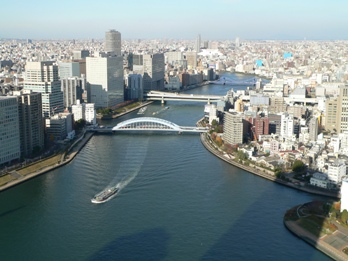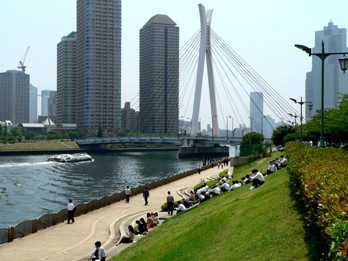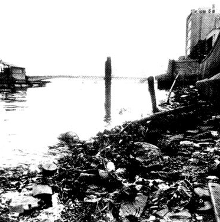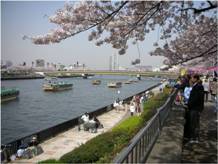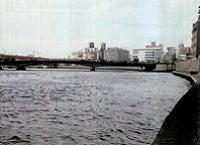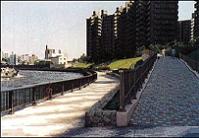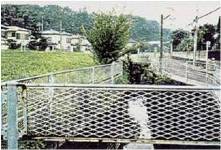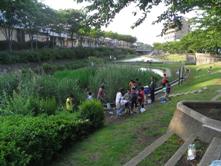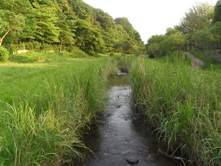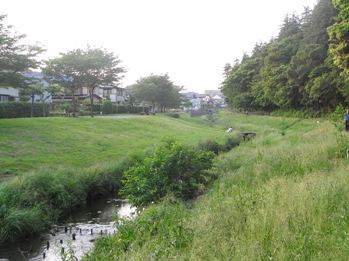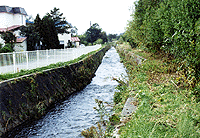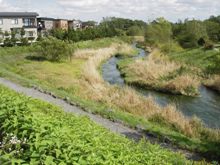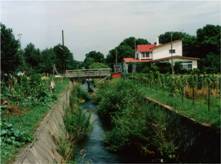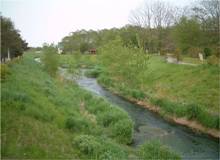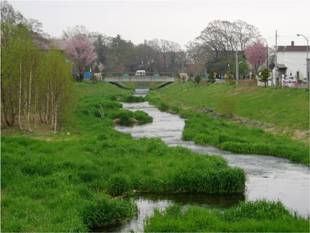|
Current condition (Source: source: Tokyo Metropolitan Gov.)
|
Sumida River around 1967
(source: Tokyo Metropolitan Gov.)
|
|
Current condition
(source: Tokyo Metropolitan Gov.)
|
Before
(source: Tokyo Metropolitan Gov.)
|
|
After
(source: Tokyo Metropolitan Gov.)
|
Postwar Sumida River waterfront was occupied by factories and warehouses, was deteriorated like a ditch, and was shunned by people. At the same time, industrial and logistical structure changes sap the area’s vitality as a production base. But increasing interest in environment headed for the semi-ruined city waterfront and a possibility of its restoration emerged and city-and-river development started, thus attractive urban area was gradually created.
The water quality of Sumida river was remarkably low in 1950s because of the industrial/domestic wastewater generated from rapid industry development and urbanization. However, after the Olympics held in Tokyo in 1964, the water quality was significantly improved by popularization of sewage water treatment system and more stricted restrictions.
Sumida river is characterized by 1) general river slope which promotes stagnant area 2) large effect of sea water that goes upstream 3) 60% of river water is treated sewage water. Therefore, efforts are being made to improve the water quality by modifying sewer system and introducing advanced waste water treatment.
In Asian nations with worsening river environments, Sumida River, improving after experiencing 50-year deterioration is a leading example in Asia.
>>More details, “River Rehabilitation with a focus on the Sumida River”(ARRN 4th International Forum held in 2007)
>>More details (PDF 50KB)
By JRRN-secre | Category: Community and urban river restoration,Kanto | Comment(0) | Trackback(0) |
Date: 2012.03.31 18:34
|
Before Restoration Project
|
|
Photo by Michiya Tannai, May 2008
|
Izumi River flowing north and south longitudinally in Seya and Izumi Wards of Yokohama City is positioned as an important river in Yokohama’s river environment improvement project called the “Community River Improvement project.”
In the first half of the ’90s, basic research related to animals and plants in watershed areas of Izumi River was conducted for preparation of river restoration and scenery and a land utilization program was launched while preserving biological resources.
Today, Izumi River attracts a great deal of attention from people engaged in river restoration work as a good case example of reproducing diversity of the river from the viewpoint of the waterfront ecological system and landscape and river utilization by citizens although it is an urban river. In 2005, this project won the highest design award of the Japan Society of Civil Engineers’ Design Prize.
By JRRN-secre | Category: Community and urban river restoration,Kanto | Comment(0) | Trackback(0) |
Date: 2012.03.30 16:19
Before
(source: RFC)
|
|
After
(source: RFC)
|
|
Before restoration project
|
|
7 years after project (Upper reaches)
|
7 years after project (Middle reaches)
(source: Iwao Araseki)
|
Moizari River, a tributary stream of Izari River in Eniwa City, used to be a rich creek where salmon spawned. The river improvement construction was done from the 1950s straightening the river course and using the triple-phase method to keep the nearby farms away from floods, but the succeeding rapid city development lowered the flood control safety level. In 1986 the river improvement was restarted, which was certified in 1990 as the second “Hometown river model project” in Hokkaido. Various nature-based methods were introduced with the theme of “waterfront with no makeup,” integrating the river with nature and greenery. River-walk has also been prepared as a part of human-nature symbiotic city development.
>>More details (PDF 112KB)
By JRRN-secre | Category: Community and urban river restoration,Hokkaido | Comment(0) | Trackback(0) |
Date: 2012.03.29 18:12
